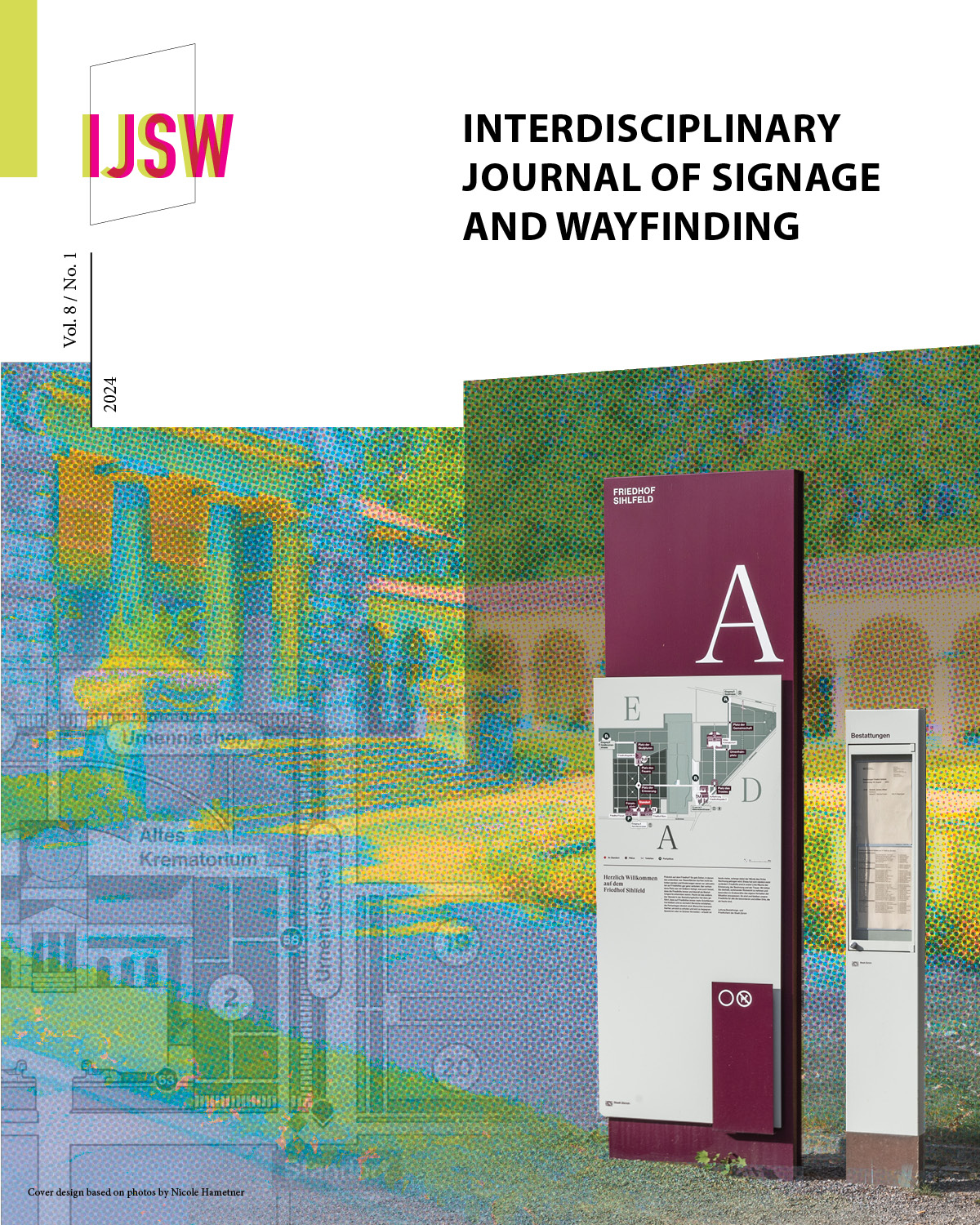The Journey to the Grave Evaluating a Swiss Cemetery Wayfinding System Using Shadowing Techniques
Main Article Content
Abstract
Signage is an aid to wayfinding and individual orientation in both organisations and everyday life. It aims to respond to users’ needs. Whether or not it actually succeeds in this can only be empirically verified by an evaluation that is tailored to the context in question. Spacious cemeteries are a particularly interesting case, as they are a place both of mourning and of relaxation. When visitors in a fragile emotional state want to find their way to a grave, they have to be able to depend on particularly effective signage. The present study of a pilot project at the Zurich Sihlfeld Cemetery in 2022/2023 uses a “shadowing” methodology in such a context for the first-ever time. This is because other common approaches to evaluating signage are inappropriate here for ethical reasons – whether these be surveys, giving test subjects specific search tasks, or using eye-tracking. We observed and assessed 49 target persons across all the segments of the cemetery in their general orientation behaviour, the degree to which they consulted the signage offered, and their use of other aids on their way to the burial in question. We used our observations to analyse deviations from the ideal access routes; our photographic records provide us with a basis for further optimisation measures.
Article Details
Section
References
Bubric K, Harvey G, Pitamber T. A User-Centered Approach to Evaluating Wayfinding Systems in Healthcare. HERD. 2021 Jan;14(1):19-30. Epub 2020 Sep 24. PMID: 32969270. DOI: http://dx.doi.org/10.1177/1937586720959074 DOI: https://doi.org/10.1177/1937586720959074
Gimpel, H. (2021). Kunden umfassend kennenlernen – Erfahrungen einer shadowing-studie an einem internationalen Flughafen. Wirtschaftsinformatik & Management, 13(3), 222–229. DOI: http://dx.doi.org/10.1365/s35764-021-00337-8 DOI: https://doi.org/10.1365/s35764-021-00337-8
Gualandi R, Masella C, Viglione D, Tartaglini D. Exploring the hospital patient journey: What does the patient experience? PLoS One. 2019 Dec 5;14(12):e0224899. PMID: 31805061; PMCID: PMC6894823. DOI: http://dx.doi.org/10.1371/journal.pone.0224899 DOI: https://doi.org/10.1371/journal.pone.0224899
Hamad, Y. (2019). Shadowing: What is it? How to use it. Where will it go? RELC Journal, 50(3), 386–393. DOI: http://dx.doi.org/10.1177/0033688218771380 DOI: https://doi.org/10.1177/0033688218771380
Interaction Design Foundation - IxDF. (2020, September 19). Shadowing in User Research - Do You See What They See?. Interaction Design Foundation - IxDF. https://www.interaction-design.org/literature/article/shadowing-in-user-research-do-you-see-what-they-see. DOI: http://dx.doi.org/10.1002/hbe2.276/v1/review2 DOI: https://doi.org/10.1002/HBE2.276/v1/review2
Johnson, Bart. (2014). Ethical issues in shadowing research, Qualitative Research in Organizations and Management 9(1) DOI: https://doi.org/10.1108/QROM-09-2012-1099
Kevdzija, M., & Marquardt, G. (2022). Impact of distance on stroke inpatients’ mobility in rehabilitation clinics: A shadowing study. Journal of Planning Literature, 37(2), 382–382. DOI: http://dx.doi.org/10.1080/09613218.2021.2001302 DOI: https://doi.org/10.1080/09613218.2021.2001302
McDonald, S. (2005). Studying actions in context. A qualitative shadowing method for organizational research. Qualitative Research, 5(4), 455–473. DOI: http://dx.doi.org/10.1177/1468794105056923 DOI: https://doi.org/10.1177/1468794105056923
Mollerup, P. (2005). Wayshowing: A guide to environmental signage, principles & practice. Baden: Lars Müller Publications. DOI: http://dx.doi.org/10.1080/17493460600845543 DOI: https://doi.org/10.1080/17493460600845543
Müller, K., & Straatmann, T. (2011). Qualitative beobachtungsverfahren. In G. Naderer & E. Balzer (Eds.) Qualitative marktforschung in theorie und praxis – Grundlagen – Methoden – Anwendungen (pp. 313–344). Wiesbaden: Gabler Verlag-Springer. DOI: http://dx.doi.org/10.1007/978-3-8349-6790-9_16 DOI: https://doi.org/10.1007/978-3-8349-6790-9_16
Parke S, Dauda N, Ayarza R. Behaviour Insight Shadowing: examining daily life settings for the prevention of neglected tropical disease. Int Health. 2022 Sep 21;14(Suppl 2):ii25-ii32. DOI: http://dx.doi.org/10.1093/inthealth/ihac042 DOI: https://doi.org/10.1093/inthealth/ihac042
Possas, M. D., & Medeiros, R. D. (2017). In the shadow of Grupo Galpao: An experience of using shadowing to understand organizing.” Administracao-Ensino E Pesquisa, 18(3), 624–654. https://raep.emnuvens.com.br/raep/article/view/544. DOI: http://dx.doi.org/10.13058/raep.2017.v18n3.544 DOI: https://doi.org/10.13058/raep.2017.v18n3.544
Quinlan, E. (2008). Conspicuous invisibility shadowing as a data collection strategy. Qualitative Inquiry, 14(8), 1480–1499. DOI: http://dx.doi.org/10.1177/1077800408318318 DOI: https://doi.org/10.1177/1077800408318318
Schmid, J. (2013). Signaletik – die zielführende Orientierung. In C. Schittich (ed.) Erschließungsräume. Treppen, Rampen, Aufzüge. Wegeführung. Entwurfsgrundlagen (pp. 40–47). Munich: Edition Detail. DOI: http://dx.doi.org/10.11129/detail.9783955531133.40 DOI: https://doi.org/10.11129/detail.9783955531133.40
Tyldesley-Marshall, N., Greenfield, S., Neilson, S. J., Adamski, J., Beardsmore, S., English, M., & Peet, A. (2020). Exploring the role of “shadowing” as a beneficial preparatory step for sensitive qualitative research with children and young people with serious health conditions. Societies, 10(1),14. DOI: http://dx.doi.org/10.3390/soc10010014 DOI: https://doi.org/10.3390/soc10010014
van der Weele, S., & Bredewold, F. (2021). Shadowing as a qualitative research method for intellectual disability research: Opportunities and challenges. Journal of Intellectual & Developmental Disability, 46(4), 340–350. DOI: http://dx.doi.org/10.3109/13668250.2021.1873752 DOI: https://doi.org/10.3109/13668250.2021.1873752
Watzlawick, P., Beavin, J. H., & Jackson, D. D. (2016). Menschliche Kommunikation. Hogrefe, vorm. Verlag Hans Huber. DOI: https://doi.org/10.1024/85745-000

